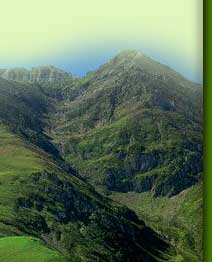Alfalfa Medicago Sativa
(Common name:- Alfalfa)
Classification

- Kingdom : Plantae
- Subkingdom : Tracheobionta
- Superdivision : Spermatophyta
- Division : Magnoliophyta
- Class : Magnoliopsida
- Subclass : Rosidae
- Order : Fabales
- Family : Fabaceae
- Tribe : Trifolieae
- Genus : Medicago
- Species : M. sativa
Alfalfa (Medicago sativa) is also commonly known as Lucerne,
Purple Medick and Trefoil.
History
Alfalfa is a member of the pea family and is native to western Asia and
the eastern Mediterranean region, where it was probably domesticated
during the Bronze Age to feed horses being brought from Central Asia. It
came to Greece around 490 B.C. being used as a horse feed for Persian
army.
First discovered by the Arabs, they dubbed this valuable plant the "father
of all foods". They fed alfalfa to their horses claiming it made the
animals swift and strong. It is widely grown throughout the world as
forage for cattle, and is most often harvested as hay.
Alfalfa has been used by the Chinese since the sixth century to treat
kidney stones, and to relieve fluid retention and swelling. It is a
perennial herb that grows throughout the world in a variety of climates.
Plant Description
Alfalfa is a cool season perennial flowering plant which grows to about
3 feet and has blue- violet flowers that bloom from July to September.
Alfalfa lives from five to twelve years, depending on variety and climate.
It resembles clover with clusters of small purple flowers. It also has a
deep root system sometimes stretching to 4.5 metres. This makes it very
resilient, especially to droughts.
Cultivation
Its wide cultivation beginning in the seventeenth century was an
important advance in European agriculture. In the United States, the
leading Alfalfa growing states are Wisconsin and California. Alfalfa,
called the "Queen of the Forages," is the fourth most widely
grown crop in the US behind corn, wheat and soybeans and double the cotton
acreage.
Alfalfa can be sown spring or fall, and does best on well-drained soils
with a neutral pH of 6.8-7.5. The soil which is low in fertility should be
fertilized with fertilizer as Alfalfa requires a great deal of potash. In
most climates, alfalfa is cut three or four times a year.
It is cultivated as an important and highest yielded forage crop because
of its symbiotic relationship with nitrogen-fixing bacteria and thus
greatly improve agricultural efficiency , producing a high-protein feed
regardless of available nitrogen in the soil.
Alfalfa is one of the few plants that exhibit autotoxicity i.e. they will
kill their own seeds. Alfalfa seed will not grow in existing stands of
alfalfa because of this. Therefore, alfalfa fields must be cleared or
rotated before reseeding.
Parts Used
The parts of the plant used is as whole herb and leaf. Alfalfa sprouts
are used as a salad ingredient in the United States and Australia. Tender
shoots are eaten in some places as a leaf vegetable. Alfalfa has the
potential to be the most prolific of all leaf vegetable crops, processed
by drying and grinding into powder, or by pulping to extract leaf
concentrate
Alfalfa has the highest feeding value of all common hay crops, being used
less frequently as pasture.
Constituents
The leaves of the alfalfa plant are rich in minerals and nutrients,
including calcium, magnesium, potassium, and carotene. It contains
vitamins A, D, E, K, U, C, B1, B2, B6, B12, Niacin, Panthothanic acid,
Inocitole, Biotin, and Folic acid. The leaves also contain flavones,
isoflavones, sterols, and coumarin derivatives. The leaves contain
approximately 2-3% saponins.
Uses
- One of the most important characteristics of alfalfa is it's high
nutritional quality as animal feed. Alfalfa contains between 15 to 22%
crude protein as well as an excellent source of vitamins and minerals.
Alfalfa hay is used primarily as animal feed for dairy cows but also for
horses, beef cattle, sheep, chickens, turkeys and other farm animals.
- The leaves of the alfalfa plant are rich in minerals and nutrients,
including calcium, magnesium, potassium, and carotene (useful against
both heart disease and cancer). The most important of these traces is
Manganese, which is vital to the human digestive system in its
manufacturing of Insulin.
- Leaf tablets are also rich in protein, vitamins E and K. Alfalfa
extract is used by food makers as a source of chlorophyll and carotene.
- It has higher ration of protein, calcium, potassium which has the
optimal use in the ration can reduce purchased supplement expenses.
Alfalfa produces at least 3 times more protein per acre than other crops
grown in U.S. dairy regions.
- Alfalfa is a good laxative and a natural diuretic. It is useful in
the treatment of urinary tract infections, and kidney, bladder and
prostrate disorders. Treating with alfalfa preparations is generally
without side effects; however the seeds contain a slightly toxic amino
acid L-canavanine.
- It is an outstanding alkalizing food and is a valuable remedy for
several ailments especially detoxifies the liver. Promotes pituitary
gland function and contains an anti-fungus agent. - Alfalfa is also
important due to its high biomass production. It is believed to be a
galactagogue.
- Alfalfa is also directly consumed by humans in the form of alfalfa
sprouts. - In addition to the traditional uses of alfalfa as an animal
feed, alfalfa is beginning to be used as a bio-fuel for the production
of electricity, bioremediation of soils with high levels of nitrogen,
and as a factory for the production of industrial enzymes such as lignin
peroxidase, alpha-amylase, cellulase, and phytase.


